Few industries are more severely impacted by operational inefficiencies than that of construction. While many other sectors are leveraging new-era tools and technologies to make productivity gains at exponential margins, construction often seems to be stuck in the past. Leaning into lean construction principles might be the industry’s saving grace.
But first… how bad is it out there?
In short, BAD. When 90% of projects fail to be completed on-time, 61% of contractors report frequent delays on their sites, and only 0.5% of data being collected is being leveraged, you have successfully concocted the recipe for mass operational inefficiency. So much so that many of the biggest projects to be tackled over the past two decades have run billions of dollars over plan.
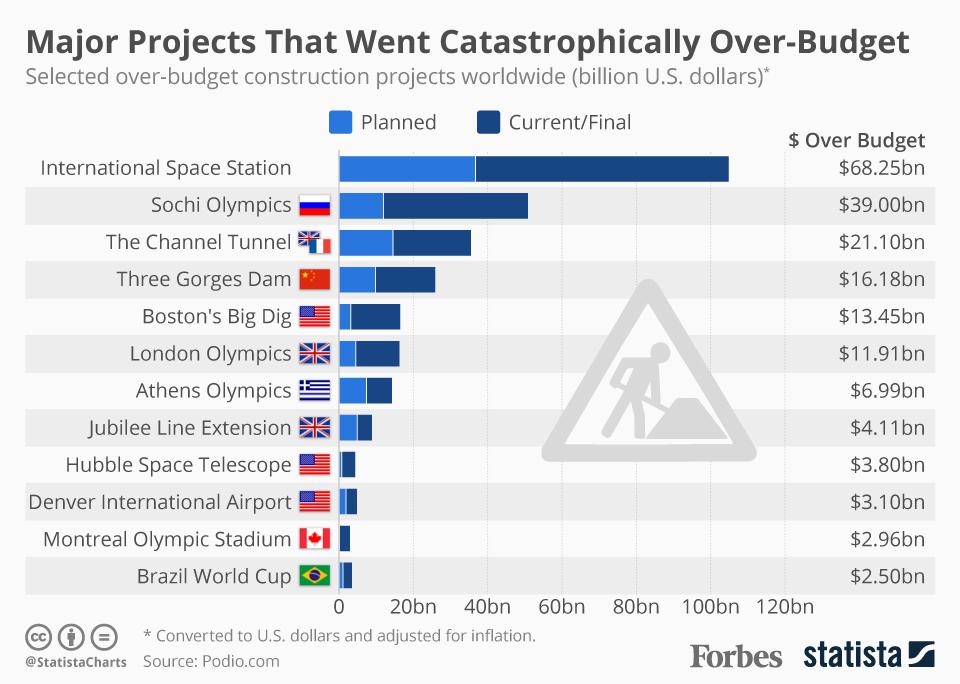
The remedy? Adopting the principles of lean construction and leveraging available technologies to recognize inefficiency early, mitigate mistakes/rework, and enhance overall site safety.
This article explores the origin of the lean construction model as well as a step-by-step process that contractors and construction firms can leverage to operationalize the lean construction principles for their businesses.
Table of Contents
What is Lean Construction?
How to Operationalize the Five Lean Construction Principles
1. Identify Customer Value
2. Identify Problem Processes that are Generating Project Waste
3. Achieve Flow-of-Work Processes
4. Use Pull Planning and Scheduling
5. Perfect the Process Through Continuous Improvement
The Lean Construction Technology Stack
1. Procore
2. myComply
Conclusion
What is Lean Construction?
Lean construction is essentially an adaptation of the lean manufacturing model that seeks to leverage careful operational research and practical design development to improve the project production process. In practice, this results in enhanced worker safety, timelier project completion, a stronger bottom line, and less waste for contractors in the construction space.
As a point of reference, here is the Toyota model for lean manufacturing:
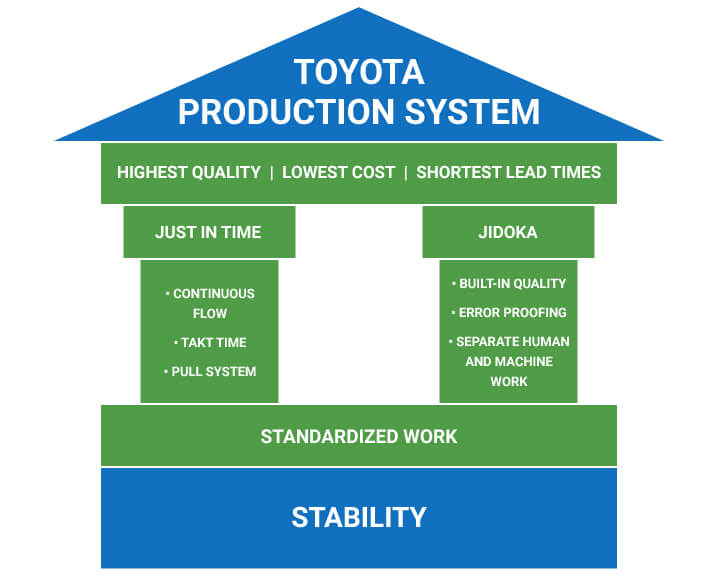
Source: 5S Today
The principles of lean construction can be applied to any project, any team, and any delivery model. That means the General Contractors (GCs) can leverage lean construction principles to reduce/eliminate project delays in the same way that a subcontractor might to improve their labor deployment.
One of the greatest challenges with the application of the lean production model to the construction space is that, unlike manufacturing, construction rarely takes place in a controlled environment. This means that achieving predictable models and cross-project gains can be difficult.
Here are some the key differences with the lean construction model:
- Controls. Unlike other industries, critical construction controls become less about “monitoring results” for incremental improvement, and more about benchmarking items like “tasks completed,” “incidents averted,” and “projections vs actual.”
- Performance. Performance should continue to be measured by an ability to maximize value and minimize waste. However, this metric should be monitored at a project-by-project level, never at an organizational level. Projects should also be compared based on past performances on projects of similar scope.
- Value. On construction projects, there are almost always a wealth of stakeholders to please. Where a traditional lean model might focus on delivering the most to the purchaser, the key stakeholders in construction can be owners, architects, engineers, GCs, subcontractors, suppliers, and more.
- Delivery. This is arguably the most complex component of lean construction. Where production timelines in manufacturing might be weeks or months, construction projects tend to span years and have an immense volume of variable inputs. Maintaining project delivery is one of the tallest tasks of all, which is probably why 90% of construction projects fail to be completed on-schedule.
- Decentralization. For construction projects to succeed, general contractors and owners need to be willing to empower downstream decision making by project information readily available and easily accessible to project managers, subtrades, and even workers.
Discover the five key lean construction principles below.
How to Operationalize the Five Lean Construction Principles
There are five lean construction principles that form the holistic lean construction model:
- Identify value from the customer’s point of view
- Identify problem processes that are generating project waste
- Achieve flow of work processes
- Use pull planning and scheduling
- Perfect the process through continuous improvement
This section explores each principle in detail and provides strategic insights on how contractors and construction firms can best implement each element of the model for optimal success.
And be sure to download this free lean construction principles infographic for future reference!
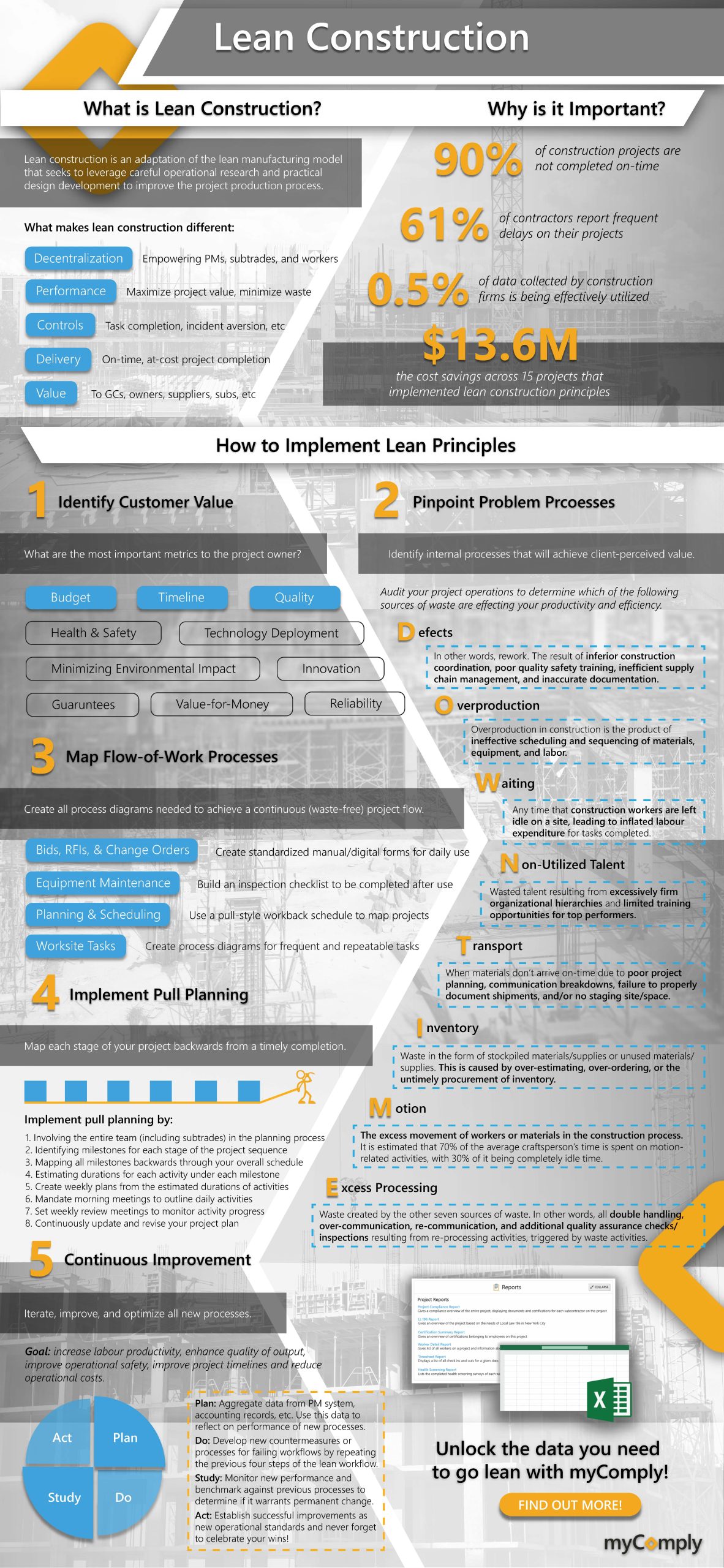
1. Identify Customer Value
Even as a General Contractor (GC) or Construction Manager (CM), you still have a client to satisfy, and that is the project/asset owner. The first step in building a lean construction program on your projects is determining what metrics each client deems to be of the most value, so you can focus on delivery. The goal here is simple: clarify client-perceived value so that a strong relationship can be built on a foundation of trust.
Project owners generally have three primary metrics that they expect contractors to adhere to, and those are budget, timeline, and quality.
Studies show that other areas of chief concern include the following:
- Health and safety
- Minimizing environmental impact
- Guarantees
- Creativity
- Technology deployment
- Innovation
- Value-for-money
- Reliability
Though it is not always possible to deliver on all client-perceived value metrics, knowing what matters most to the customer can help you to better manage expectations throughout the course of the construction project and drive client satisfaction.
To truly embrace lean construction, you don’t stop with client-perceived value. You should also look to understand perceived value from the perspective of all other stakeholders, including architects, engineers, subcontractors, suppliers, and more. By conceptualizing and mapping out value in the eyes of each stakeholder, you are effectively building the foundation for the remaining lean construction principles.
2. Identify Problem Processes that are Generating Project Waste
Though you want to execute the lean construction model for all stakeholders, our exploration will focus on the core element of client-perceived value. Once you’ve identified key value metrics, you then need to clarify the day-to-day work processes that will deliver the desired value and eliminate the desired waste.
Most waste in the construction sector can be characterize by one of the eight sections under the “DOWNTIME” acronym.
Defects
Defect can be explained as any work that is not completed correctly on the first attempt. In other words, rework. Rework activities are one of the leading causes of inefficiency in construction. In fact, a survey conducted by PlanGrid and FMI found that the global construction sector spends an approximate $178 billion a year on rework activities.
The top-four causes of rework in construction include:
- Inferior construction coordination
- Poor quality and safety training
- Supply chain management
- Inaccurate documentation
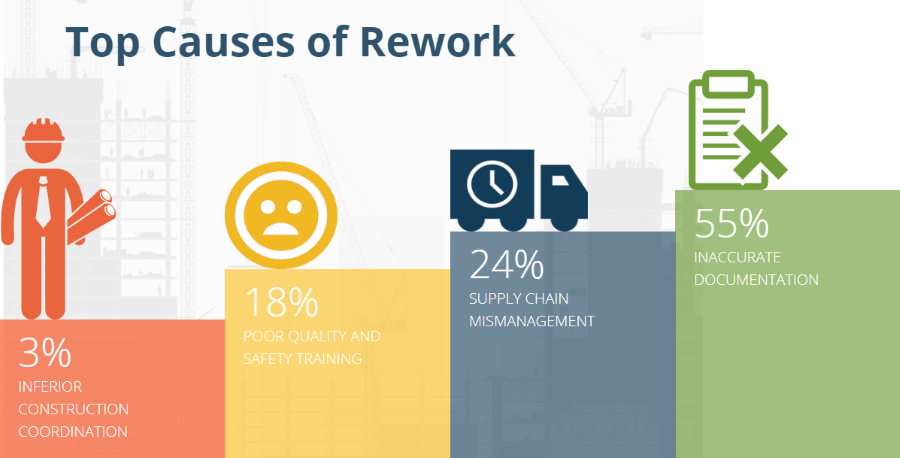
Source: Autodesk
If these rework activities and change orders are commonplace on your project sites, then you should begin investigating the root of those orders so that you can determine where there are opportunities to lean-up your operation.
Overproduction
Though overproduction is a more prominent issue in the manufacturing sector, it often presents itself on construction projects in the form of ineffective scheduling or sequencing.
For example, the construction equivalent of overproduction might be an electrical contractor completing their work five weeks prior to an interior finishing contractor being scheduled. This can result in project delays that would have otherwise led to a timelier project completion.
One of the best tools for contractors looking to adopt lean construction principles and mitigate the risk of overproduction is a project management system, such as Procore or BIM 360.
Waiting
Waiting is any time where workers may be left idle on a construction site. Waiting is generally the result of inefficient scheduling or sequencing (as mentioned above), or inefficiently scheduled material deliveries.
This is a pervasive problem in the construction sector. A study by the University of Michigan’s Center for Construction Engineering and Management found that many construction subtrade workers spend in-excess of an hour a day waiting.
The numbers are as follows:
- Bricklayers: 45 minutes
- Carpenters: 62 minutes
- Roofers: 75 minutes
- Electricians: 80 minutes
- Plumbers: 83 minutes
This is all time that could easily be re-allocated towards productive task work through the adoption of lean construction principles. The cost of “waiting” is inflated labor costs for work completed. Worse yet, sometimes this wait time is spent off-site, with contractors still being billed for those minutes every day. Time and attendance solutions like myComply can help contractors to better monitor this downtime so that they can reduce labor expenditure in the case of excessive “waiting.”
Non-Utilized Talent
Non-utilized talent is one of the least recognized sources of waste in the lean construction model. It can be described as the loss or inadequate use of labor capability/resources within the project production process. Due to the sheer size and complexity of most construction projects, it can be difficult to understand what talent might be going under-utilized.
This waste is the result of one of the following drivers:
- Excessively firm organizational hierarchies. Nothing limits worker potential as much as a bureaucratic and highly enforced “order of command.” When workers don’t feel that they have the freedom to contribute beyond their basic roles and responsibilities, productivity suffers.
- Limited training opportunities. Organizations that don’t invest in improving their workers skillsets or cross-training workers for other tasks will eventually suffer greater at the hands of turnover and under-utilization of talent.
The bottom line is that construction companies that don’t build a culture of employee reward and opportunity will struggle to succeed in deploying the lean construction principles. If training and improvements are only sought at managerial levels, then fewer effective ideas will reach project production.
Transport
Transportation is the waste that lies on the flipside of most “waiting” waste and can generally be attributed to the inefficient movement of materials, inventory, supplies, or personnel. Construction projects require a great degree of supply chain management to ensure the timely arrival and delivery of all materials necessary to complete project work, making this one of the most prominent processes that inhibits the success of a lean construction program.
Some of the leading causes of transportation waste are:
- Project planning. Planning is one of the most critical components of project success, but it is one of the most difficult to implement, due to the sheer complexity of most medium to large-sized projects. This process starts as early as the design phase and must be constantly tweaked and updated throughout project production to ensure transportation needs are met.
- Communication breakdowns. The reality is that no matter how strong your plan is, things will inevitably change throughout the course of a construction project. When these changes occur, it is critical that they are clearly communicated to all relevant stakeholders and documented in your project management system, so that you can minimize the risk of miscommunication.
- Failure to document items in shipments. There is a lot of room for human error with respect to transportation. It is easy for items to be missed, or falsely accounted for on shipments, which is why it’s important to create checklists for all items on each load. A checklist on each side of every delivery will ensure that all necessary supplies and materials make it to site on the first attempt.
- Lack of, or inability to, stage equipment. Not all sites have the space to permit staging areas, but those that do provide contractors with a bit of a buffer, enabling them to receive equipment and supplies ahead of schedule and prepare them for utilization.
If you suspect that your organization is failing to complete any of these tasks, or is suffering from one of these ailments, then you should investigate that process and prepare to deploy new operational guidelines or technologies, aimed at improving the efficiency of goods transport.
Inventory
Inventory waste in construction is characterized as stockpiled materials and supplies, resulting from over-estimating, over-ordering, or untimely procurement. However, it can also be the unnecessary/inefficient use of materials, which can lead to material waste and over-expenditure. Inventory waste is a rampant issue in construction, with as much as 30% of all building materials ending up as waste, contributing 150 million tons of landfill waste, per year.
The name-of-the-game for leaning up your construction inventory management process is just-in-time delivery. This principle is derived from Toyota’s just-in-time manufacturing model and requires extensive supply chain management.
The just-in-time principle is simple: ensure that there are sufficient materials on site to produce only what is needed, when it is needed to maximize volume of work produced while also minimizing the inventory on-hand.
Here is what the just-in-time inventory process looks like:
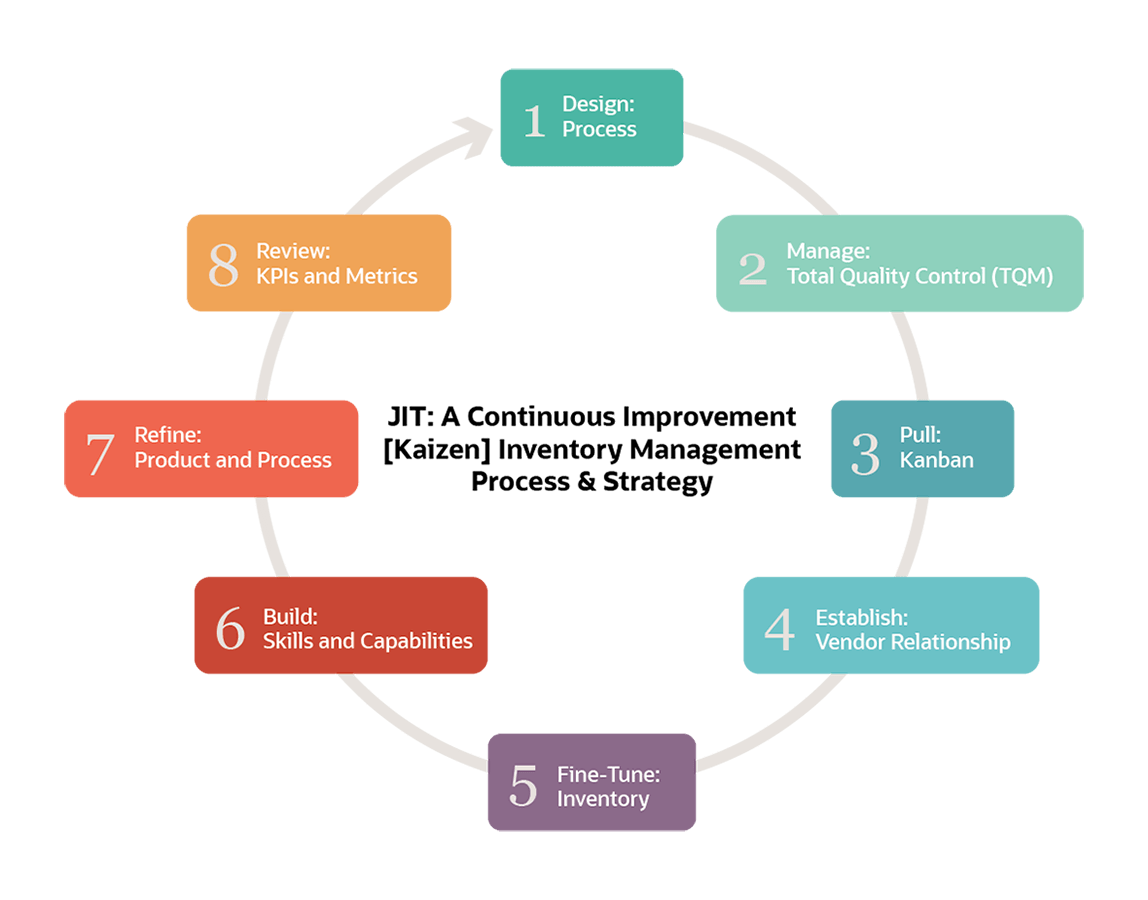
Source: NetSuite
And here is what is involved in each step of the just-in-time inventory process:
- Design. This is where the inventory management process begins in construction; taking architectural plans and turning them into building information models that map inventory schedules for the duration of the project.
- Manage. This involves the clarification of roles and responsibilities surrounding inventory management to ensure that schedules are accurately managed and updated.
- Pull. This is the key to it all. Pulling inventory into the production cycle as efficiently as possible so rather than storing and stocking materials.
- Establish. This is the contract negotiation and clarification stage where lead times and delivery expectations can be clarified and optimized.
- Fine-tune. Iterate and improve.
- Build. Empower your team with knowledge and understanding surrounding materials delivery and usage plans.
- Refine. Eliminate unnecessary steps in the process and implement standardization across your projects.
- Review. Assign quality measures and closely monitor key metrics to ensure that continuous improvement is consistently achieved.
The greatest opportunity for inventory optimization in construction lies in the “pull” and “establish” phases where materials deliveries are optimized for. This topic leads into the fourth lean construction principle, using pull planning and scheduling, which we will explore further below.
If you are not practicing a just-in-time delivery model on your projects, then you need to invest in supply chain management resources and staff so that you can optimize your delivery schedules.
Motion
Motion can be defined as any activities where movement is required, be that the movement of materials or workers. Construction sites are high-activity zones, so small reductions in movement can lead to large productivity gains. In fact, time spent searching for tools, information, and other daily coordination activities eat up an estimated 70% of a craftsperson’s billable project time.
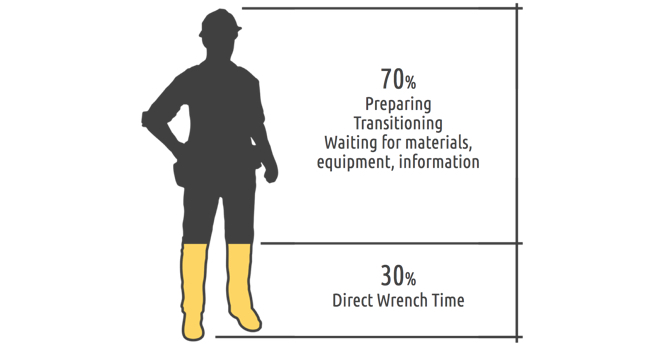
Source: Fieldwire
The exact breakdown of motion waste for journeymen construction workers is as follows:
- 30% of time is spent building/laboring (direct wrench time).
- 40% of time is spent preparing for tasks, gathering equipment/materials, and transitioning work areas.
- And as much as 30% is spent idling, which is not contributing towards any project outcomes. This is the direct result of outdated management processes and the failure to implement lean construction principles.
Excess Processing
The final cause of construction waste is excess processing. Excess processing can be defined as the collective waste that is created by the other seven sources of waste. In other words, excess processing is what happens when issues such as defects cause project delays and result in (otherwise) unnecessary processing, such as additional quality assurance checks/inspections.
Additional activities that contribute to excess processing waste include:
- Double handling. This is what happens when products and materials are delivered to the construction site incorrectly, resulting in additional machine and operator handling.
- Over-communication. This is the result of communicating more than necessary in an operational process. Over-communication is often a tough waste to isolate as the costs of under-communicating can be even greater. Surveying workers to determine whether they feel that existing communication channels are effective is a great way to begin optimizing project communication.
By implementing the second phase of the lean construction principles, you are prioritizing the identification of waste on your project sites and are taking the first step towards implementing the processes that will minimize and reduce waste, creating opportunity for major productivity gains.
3. Achieve Flow-of-Work Processes
Once areas of waste have been identified, it is time to begin assessing opportunities to enhance the overall flow-of-work. The goal of this step is to achieve a continuous workflow, from pre-construction through to completion, that is not only reliable and predictable, but also repeatable. Achieving flow-of-work processes means that every phase of the construction project is perfectly sequenced, eliminating waste in all key areas of your operations.
Though there are several flow-of-work processes on construction projects, there are five critical buckets that should be assessed and mapped using different tactics. Here are those workflows:
Note: Though these workflows are best enabled with the assistance of software, we will provide a manual formatting recommendation for each.
Or, skip to the lean construction software stack!
1. Bids, RFIs, and Change Orders
Bids, requests for information (RFIs), and change orders are the workflows that are triggered when certain forms of waste are occur, such as defects, overproduction, transportation/inventory errors, and more.
When mistakes are made or information fails to be communicated, change orders and RFIs are issued. These can be overly complex, confusing, and lead to rework and other project delays.
Best manual format: form
To build a stronger bid, RFI, and change order processes, a standardized form should be created and made readily available to on-site workers in either a hard-copy format or digitally through your project management system.
2. Planning and Scheduling
To call most construction projects complex would be the understatement of the century. There are infinite volumes of moving parts throughout the span of most projects. To succeed, all these moving parts need to be organized and coordinated with precise and deliberate action so that there is little to no waste.
Best manual format: work-back schedule
A work-back schedule is a variation of a flowchart that starts with a project completion or delivery date, then works backwards to schedule in all the task specific milestones that lead to completion. This is an effective way to ensure that project timelines are upheld. Learn more about how to implement this type of planning at the project level in section 4 of the lean construction principles.
3. Worksite Tasks
Worksite tasks contribute towards the project milestones that then contribute towards the completion of a project. Project Managers (PMs) should create task documentation for any activities that are often repeated on the jobsite, so that workers can quickly be educated on optimal behavior and minimize waiting/motion waste.
Best manual format: process outline
A step-by-step process outline can clearly outline the expected order of operations for repeatable tasks, such as pouring concrete, or picking materials. This encourages workers to follow instructions rather than defaulting to personal processes that might be wasteful.
4. Equipment Maintenance
The condition of equipment on a project is a critical component of the overall construction process. Furthermore, the inability to predict wear-out and replacement requirements can lead to lost-time, unnecessary waiting, and even project delays.
Best manual format: checklist
Creating a simple equipment inspection checklist that can be conducted following the completion of any task can be helpful in predicting wear out and ensuring for timely repairs and replacements.
4. Use Pull Planning and Scheduling
Pull planning is a reverse approach to project planning that starts with the finished project and project milestones (such as completion dates of various phases) and works backwards through the steps that enable the achievement of those milestones.
Here is a high-level overview of the difference between pull planning and push planning:
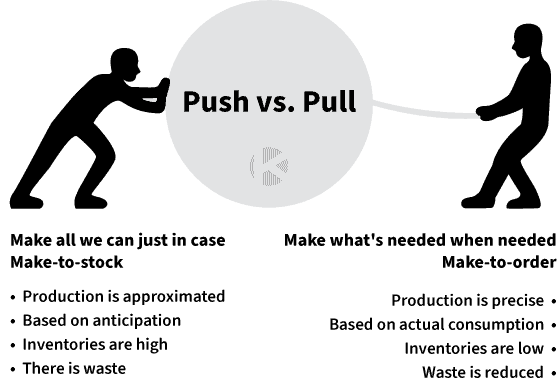
Source: Kanban Zone
When pull planning is implemented effectively, the benefits to your overall lean construction model are substantial. Pull planning requires extensive communication which improves project-wide collaboration and gives each worker a greater sense of transparency and involvement/ownership in the project. But, most importantly, pull planning serves as a mechanism for improving project efficiency. As sited earlier, 90% of projects fail to be completed on-time. Taking a pull stance to project timelines is one of the most effective tactics for reducing those numbers and improving success rates.
Pull planning is the last operational phase of the lean construction principles.
How to Implement Pull Planning
To implement a pull planning system into your lean construction model, there are several steps that need to be taken, with an emphasis on collaboration and team-wide transparency.
The steps are as follows:
- Involve the entire team. You need to establish buy-in across your internal team as well as the subtrades that operate within your project before you implement a pull planning strategy. Each major player should also contribute their estimates for project milestones so that an accurate timeline can be developed.
- Adhere to project milestones. Once completion milestones are established, your team should develop a phase plan that sequences each of the major milestones in the order of project operations.
- Determine a schedule. Organize all the activities that are identified under your project milestones and fit them into your overall project schedule.
- Establish durations. Based on historical performance and data, estimate accurate activity durations.
- Map weekly plans. Take your phase plan and break it out into activities on a weekly basis. These activities then form the work plans for each week.
- Book daily morning meetings. Continuous and frequent collaboration is key to the success of a pull planning system. One of the best methods for ensuring a high degree of collaboration is by instituting daily morning meetings where supervisors and project managers (PMs) can outline the daily activities and progress towards weekly goals.
- Book weekly review meetings. It will not always be possible to adhere to projections, so it is important to have weekly meetings where activities can be documented, and any necessary adjustments can be made to the activities schedule.
- Continuously update the plan. Your project plan should be viewed as a living, breathing document, not a manuscript. Regular updates help you make the necessary adjustments and allowances to stay-on-track and meet your milestones.
5. Perfect the Process Through Continuous Improvement
This is the pivotal principle of lean construction. If you have successfully implemented the first four stages of the lean construction model; that means, it is time to iterate and improve on the work you have done thus far.
Continuous improvement is the notion that no matter how functional a process or operation might be, there is always room for further improvement or optimization. This framework, as it has been popularized today, is also known as the Kaizen model. The model is a structural representation of how organizations can continuously implement change in a methodical and calculated way.
For a little bit of history, the word “kaizen” is of Japanese origin and belongs to a school of business philosophy which holds that “change is good.” In fact, the roots of the word are “kai,” meaning “change,” and “zen,” meaning “good.”
With respect to construction specifically, continuous improvement processes should aim to:
- Increase labor productivity and improve project timelines.
- Enhance quality be implementing stronger operational practices.
- Improve safety by focusing on what really matters: the workers.
- Boost operational efficiencies from the office, down to the frontlines.
- Reduce costs through fewer delays and better adherence to project scope.
Here is what the process looks like in-action:
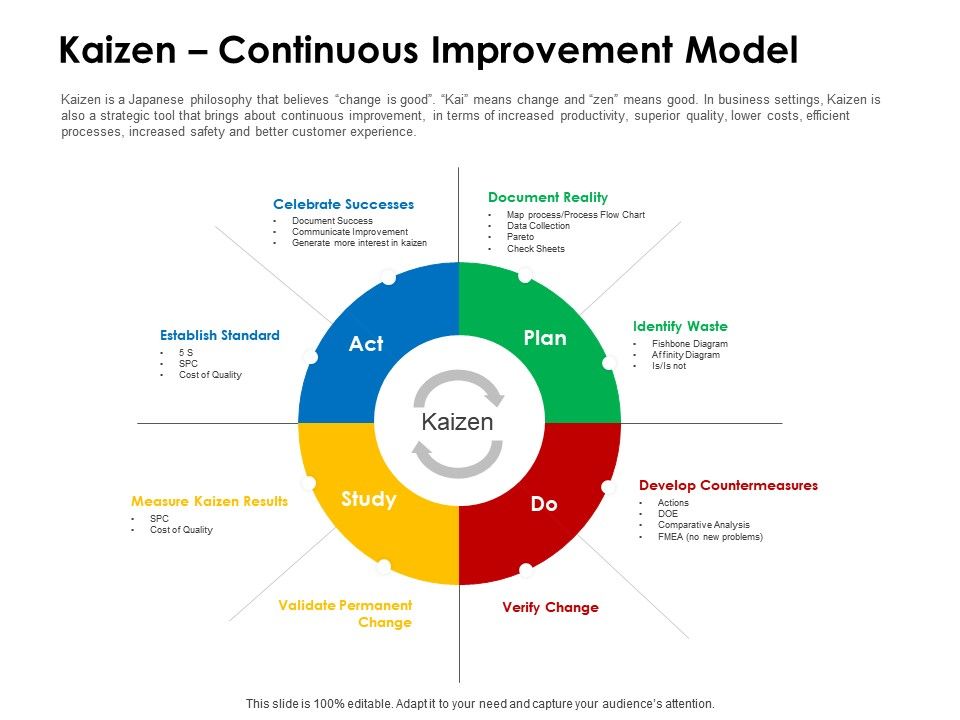
Source: Slide Team
There are four primary stages in the Kaizen model:
- Plan. This is the data aggregation phase. Though the first steps of the lean construction model can be performed with less data, step-5 demands accurate reports of operational performance. Contractors need to mine their project management systems, their accounting records, and other construction technology solutions to determine where bottlenecks occur and where the greatest opportunities are to iterate and improve.
- Do. Once you know where the problems are occurring, it is time to begin developing countermeasures that can be implemented, aimed at reducing waste and enhancing productivity.
- Study. After you have implemented any change; you need to closely monitor the resulting performance. In doing this and comparing against benchmark metrics, you can determine whether you should make a permanent process change.
- Act. Not all change will result in improvement, but the changes that succeed should be established as new operational standards. Additionally, you should always celebrate your wins as this helps to foster acceptance and reduce the impacts of change management.
If done properly, a focus on continuous improvement should help you transform the principles of lean construction into a central element of your organizational and operational culture. That means saying goodbye to the outdated “it’s always been done this way” beliefs and embracing a culture of change, openness, and deep-seated collaboration.
The Lean Construction Technology Stack
Now that we have explored the five lean construction principles in detail, it is time to examine the top lean tech in the space. Now, let’s face it, there are hundreds (if not thousands) of construction technology solutions that are designed to improve productivity and drive lean outcomes on construction sites. However, not all these solutions were created equal. What we have done is provided you with the top solutions that you should implement to drive the greatest impact for the least expenditure.
1. Procore
Procore is the leading project management software for contractors in the construction space. It is already powering some of the largest general contractors (GCs) in the world and has been used on over one million projects around the globe.
Procore’s platform provides contractors with everything they need to manage and automate every stage of the construction process, from bidding, all the way through to fiscal management. If you are looking to adopt a lean construction model, Procore is almost essential.
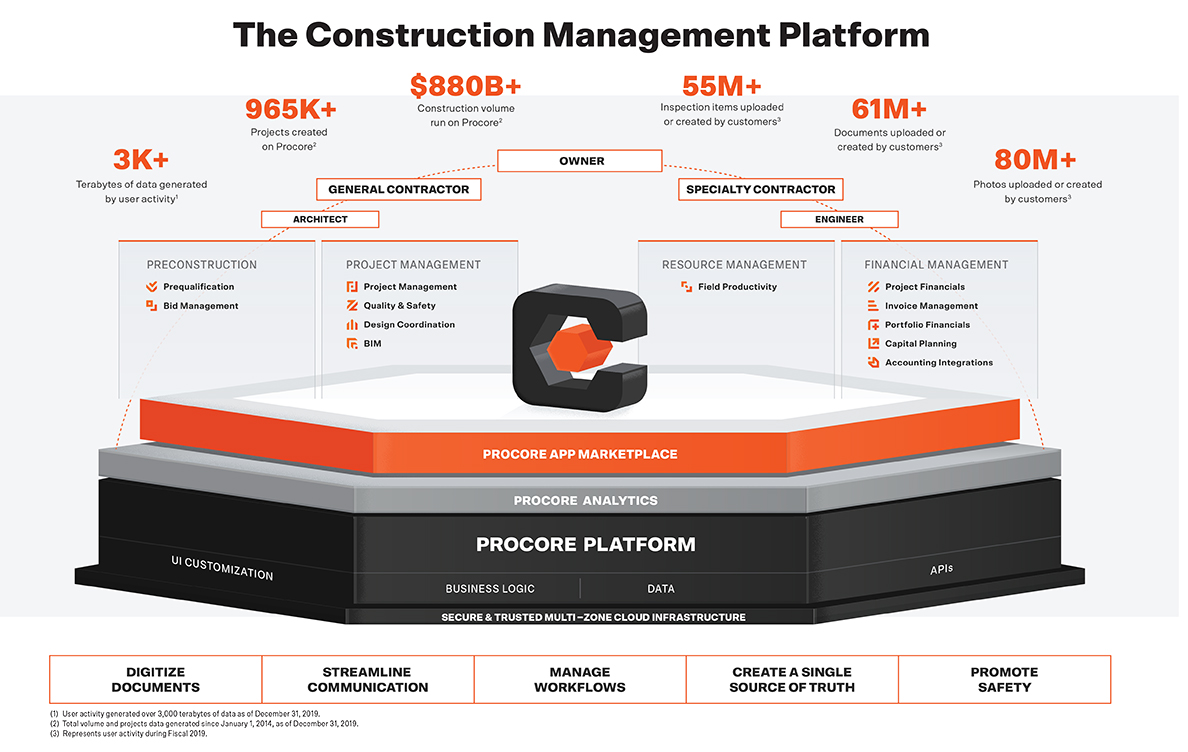
How Procore supports the lean construction principles:
- Enhanced bidding accuracy through intelligent bid management, which leads to more realistic and achievable project timelines.
- Intelligent workflow mapping which enables the creation of fluid digital pull plans that can encompass all project milestones and activities.
- Document digitization which allows for RFIs, invoices, change orders, and other key documentation to be digitally managed, updated, and accessed from any mobile device.
- Reducing transportation and inventory waste through the usage of building information modeling technology.
2. myComply
One of the greatest challenges that contractors and construction firms face when implementing the Kaizen model, and other elements of the lean construction principles, is the ability to acquire sufficient data or reliable data that can be used to inform decisions.
myComply makes otherwise difficult data to access readily available to GCs and construction managers through its integrated project dashboard and access control technology.
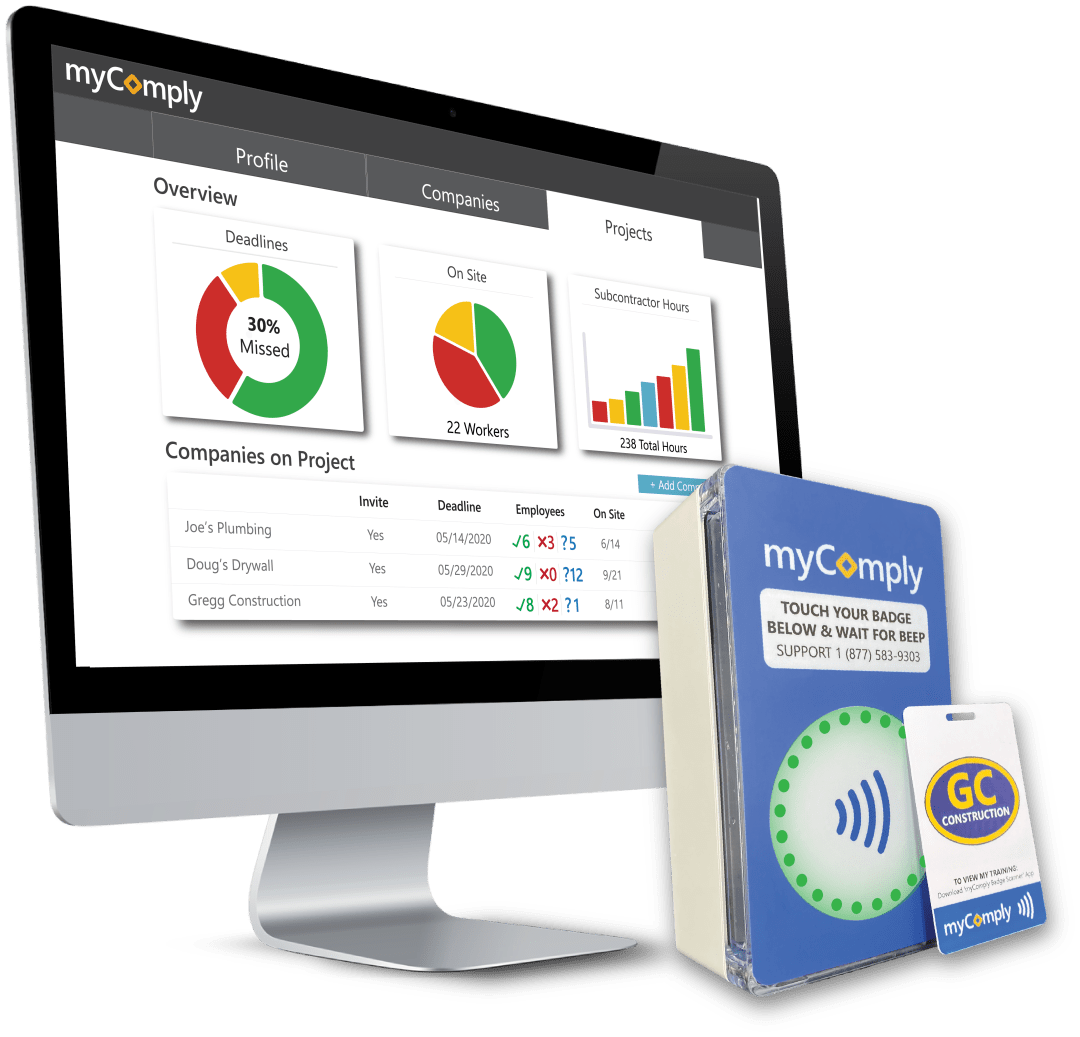
How myComply supports the lean construction principles:
- Enhanced timesheet accuracy through myComply’s Access Control This allows contractors to eliminate labor inflation by tracking all worker and subtrade hours down to the minute. This also helps to eliminate both waiting and motion wastes. Timesheet accuracy also means implementing a system that cannot be easily cheated or fabricated; access control systems offer elevated accuracy in terms of time and attendance data.
- Stronger project oversight. With real-time reporting on hours, it is easy to stay on-budget with what has been allocated for each project milestone.
- Automated reports eliminate the paperwork that often associated with more complex lean construction project models. Example reports include worker details, timesheets, certification summaries, health screening reports, orientation status, as well as project compliance reports.
- Subcontractor management through project enrollment. myComply allows GCs to create projects and add each subtrade onto the project so that they can build a high-level overview of the project and better facilitate the creation of pull planning. This also facilitates the instant transfer of information from subcontractors to GCs. All data is stored in a secure cloud repository, eliminating large sums of administrative toil.
Explore additional construction technology solutions here: Construction Technology: Adopt or Die
Conclusion
Adopting the lean construction principles outlined in this article may require substantial organizational change. However, the numbers speak for themselves.
Just remember:
- 90% of construction projects are not completed on-time
- 61% of contractors report frequent delays on their projects
- Only 5% of data collected by construction firms is being effectively utilized
- And the implementation of these lean construction principles led to $13.6M in cost savings across 15 projects.
Don’t forget to download your lean construction principles infographic!
If you are ready to lean-up your operations and unlock otherwise inaccessible data, then myComply is a must-have lean construction solution for your company. Book a demo today to find out more.




You described the importance of good management of a team throughout this article. Such achievements could be a dream to come true if the whole process is done without any specific target to get completed. Any work or project needs the hard work of the entire team to be successful and to show its full potential outcomes. I am glad that your team is collaborative in this way.
Thank you for pointing out that the construction sector has grown more information-based due to advances in technology. Having a sturdy and long-lasting construction is necessary for any aspiring building owner.